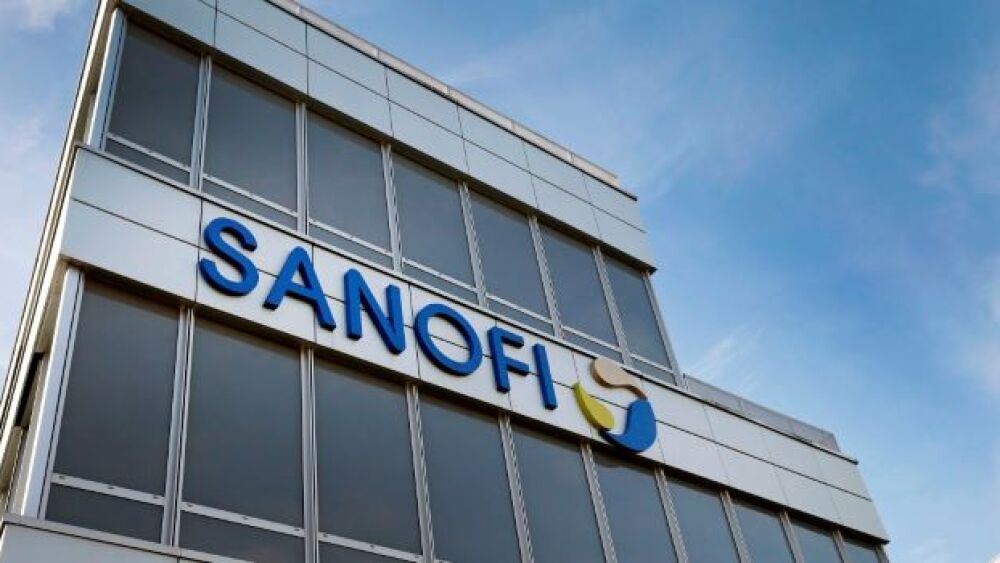Sanofi announced positive data for its therapeutic, fitusiran, for treating patients with hemophilia A and B, as well as efanesoctocog alfa therapy for treating hemophilia A.
Chesnot/Getty Images
Sanofi announced positive data this weekend for its therapeutic, fitusiran, which is being developed to treat patients with hemophilia A and B as well, as efanesoctocog alfa therapy for the treatment of hemophilia A. The Paris-based company released its findings at the International Society on Thrombosis and Haemostasis (ISTH) congress.
In a partnership with Alnylam Pharmaceuticals, Sanofi reported on the Phase III ATLAS-PPX study which demonstrated that fitusiran dosed once a month led to a 61% decrease in the annualized bleed rate (ABR) over a seven-month follow-up period versus previous therapy with either blood clotting factor replacement or bypassing agents (BPAs). Fitusiran is an RNA interference (RNAi) therapeutic that targets antithrombin. This therapy is designed to require as few as six injections a year.
Adults and adolescents receiving fitusiran essentially experienced zero treated bleeds compared to 16.9% with a prior factor or BPA prophylaxis. The median ABR for treated bleeds was 0.0 with fitusiran prophylaxis for both participants with and without inhibitors compared to 6.5 and 4.4 for participants with and without inhibitors, respectively, on prior prophylaxis. Of the 67 trial participants who received at least a single dose of fitusiran, the most common adverse events were increased alanine aminotransferase, nasopharyngitis and upper respiratory tract infection.
“These positive data support fitusiran’s potential to transform prophylaxis treatment for people with hemophilia A or B, with or without inhibitors, with a median annual bleed rate of zero across all patient populations,” Dr. Dietmar Berger, M.D., Ph.D., global head of development and chief medical officer of Sanofi said. “Moreover, we are excited to continue to explore fitusiran under an amended protocol that focuses on dose optimization, including lower doses and less frequent dosing regimens, with the potential for as few as six injections per year.”
There have been some issues with blood clotting, which caused the U.S. Food and Drug Administration to place a clinical hold in 2017. The hold was lifted the same year. Sanofi had been considering a regulatory filing for the drug this year but has pushed back the timeline, possibly as far as 2024, to collect more data on a dosing schedule that would use lower doses to avoid the potential clotting issues.
Numerous companies are jockeying for position in the hemophilia space. Sanofi is approaching the disease with three different strategies, engineered proteins, RNAi and gene therapies.
Sanofi-Sobi Partnership Also Yields Phase III Fruit
The company also presented data on the Phase III XTEND-1 study, which compared efanesoctocog alfa therapy to patients receiving previous treatment with clotting factor replacement. Sanofi is partnered with Swedish company Sobi (Swedish Orphan Biovitrum AB) on the drug, a novel and investigational recombinant factor VIII (FVIII) that is engineered to extend protection from bleeds with a once-a-week prophylactic dosing for individuals with hemophilia A. It leverages Fc fusion technology by adding a region of von Willebrand factor and XTEN polypeptides to extend its circulation time.
The trial hit the primary efficacy endpoint, with once-weekly efanesoctocog alfa prophylaxis demonstrating clinically meaningful bleed protection for severe hemophilia A patients. The median and mean annualized bleeding rates were 0.00 and 0.71, respectively. It also met the key secondary endpoint, demonstrating superior bleed protection compared to previous factor VIII prophylaxis with an estimated ABR reduction of 77% and a mean ABR of 0.69 compared to 2.96 on prior prophylaxis.
Dr. Annette von Drygalski, M.D., PharmD, investigator, professor and director of the Hemophilia and Thrombosis Treatment Center, UC San Diego, said, “The Phase III data demonstrate once-weekly efanesoctocog alfa’s potential to provide superior bleed protection, leading to substantial improvements in physical health, pain and joint health, by sustaining high factor levels for the majority of the week. These unprecedented results may offer people with hemophilia A the possibility to redefine their treatment expectations.”
Roche’s Hemlibra (emicizumab), a bispeciic antibody that restores the hemostatic process, is one of the top-selling drugs in the space. It essentially mimics the action of clotting Factor VIIIa. It was approved in 2018, and in 2021 accounted for about 85% of the global market.
Other companies attempting to enter the market include uniQure and CSL Behring with etranacogene dezaparvovec, a gene therapy for adults with hemophilia B, which is under review by the FDA. In May, the FDA requested more information from BioMarin Pharmaceuticals regarding its Biologics License Application (IBLA) for valoctocogene roxaparvovec for hemophilia A. The regulator wanted more durability and safety data. The company expects to resubmit the BLA by the end of September.
Novo Nordisk Also Carving Out Hemophilia Niche
Novo Nordisk also reported Phase III data at the conference this weekend. Its concizumab is an anti-tissue factor pathway inhibitor (TFPI) antibody for once-daily prophylactic treatment for all types of hemophilia. The data demonstrated an 86% decrease in treated spontaneous and traumatic bleeds when on concizumab prophylaxis, with an estimated mean ABR of 1.7 compared to 11.8 with no prophylaxis. This was the primary endpoint. The overall median ABR was zero, compared to 9.8 for no prophylaxis.
“One of the most critical complications in the treatment of hemophilia is the development of inhibitors, as they render standard replacement therapy ineffective and severely limit treatment options for hemophilia B,” Dr. Victor Jiménez-Yuste, M.D., explorer7 lead investigator, haematology department, La Paz University Hospital, Madrid, Spain said. “Based on the results of the explorer7 study, there is a potential for concizumab to become a new treatment option for people living with hemophilia A or B with inhibitors.”





